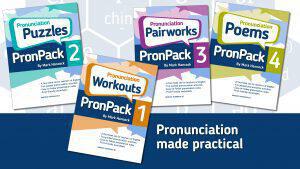PronPack Book Review by Maria Davou
Books: PronPack 1 Workouts / 2 Puzzles / 3 Pairworks / 4 Poems
Name of Author: Mark Hancock
Year and place of publication: 2017, UK
Publisher: Hancock McDonald ELT
Number of Pages: 62 / 62 / 64 / 70
Price: € 13,50 per book at DES ISBN: 978-0995757516 / 978-0995757523 / 978-0995757530 / 978-0995757547
Summary of PronPack Book Review
Hancock McDonald’s PronPack (2018 ELTons winner) is a set of four books with pronunciation activities. Each book focuses on a different kind of activities: Workouts includes extended drills focusing on specific aspects of English pronunciation but also focuses on raising learners’ awareness of the phonological system of the English language, by encouraging them to analyze and use individual sounds. Puzzles offers game-like activities that can be used in various interaction patterns and that mainly include matching or comparing sounds or stress patterns. Pairworks has information gap activities, mainly to be used in pair and group work, and finally, Poems (my favorite!) promotes pronunciation practice through rhymes, chants, limericks and raps. The four books are independent from one another and can be purchased and used separately but I have been using all four as they give a wider range of activities to choose from with different levels and ages. The books are very easy to use, with clear instructions for the teacher, a timeframe for your lesson and a photocopiable worksheet for the students.
Background
Pronunciation is the number one reason for communication breakdowns in real life exchanges, with mother tongue interference being one of the greatest, if not the greatest, causes of mispronunciation of foreign words.
It is no secret that most teachers and materials tend to focus on the teaching of the grammatical and lexical systems, paying little attention to teaching pronunciation. Although most exams set out pronunciation as one of the criteria in their assessment scales (Pronunciation is worth 25% of the IELTS Speaking mark and in Cambridge First (FCE) Speaking is worth as much as Grammar and Vocabulary combined), most coursebooks dedicate extended practice on presenting and practicing new lexis and grammatical structures, giving limited or zero space and time for pronunciation practice. The same goes for teachers who see it as time wasted or a side-activity that will be done if time permits. However, research is clear: learners with a greater sense of their own pronunciation ability tend to have lower “foreign language learning anxiety” in general (Shams, 2006; Baran-Łucarz, 2011) and that pronunciation affects grammar, vocabulary, and the four skills. Yet, it is still downplayed in the language classroom. Butin fact, time spent teaching pronunciation is time well spent! In personal discussions with teachers, you might find out that they are aware of the importance of pronunciation in mastering the language, but they feel they do not know how to incorporate pronunciation work in their lesson and at best, they include some choral drilling activities. This is precisely the gap that Hancock McDonald’s PronPack books attempt to fill.
PronPack Book Review
Through an innovative, user-friendly and practical set of a wide variety of activities offered in the four PronPack books, teachers have ready-made pronunciation tasks for different levels and age groups to include in their lesson.
The first book, Workouts, familiarizes learners with the sounds of the English phonological system through a series of easy-to-use awareness-raising worksheets, which also tap on the relationship between sounds and spelling. The focus of each worksheet ranges from individual sounds through consonant clusters and word stress to connected speech and tonic stress. Students not only become aware of these features when listening to them, but they get the opportunity to practice producing these features, moving their tongue around and understanding how muscle helps with pronouncing correctly!
The second book, Puzzleshas more game-liked activities that can be used in different interaction patterns in the classroom (individual work, pair work and group work). The types of activities include mazes, wrongly written words, word chainscrosswords, sudokus and word soups. These activities help students to become aware of certain patterns in the pronunciation system of English while playing, problem and puzzle-solving
The third book, Pairworks, includes very interesting information-gap activities and games, which help students realize how pronunciation affects meaning. The activities range from minimal pairs to word stress and contrastive stress. Students have to perceive and produce important phonological distinctions, with a focus on getting the meaning across effectively to a partner.
The fourth book, Poems, is my personal favorite! It contains 18 worksheets withpoems, rhymes, chants, raps and songs for working on different areas of English pronunciation, focusing on individual sounds or weak forms, simple past regular verb endingsor features of connected speech, combinations of words consonant discrimination or subject and object pronouns.
Final word
As I usually say in my talks, seminars and workshops, pronunciation work should find its place in our lessons and it should be part of our syllabus design from the beginning of teaching the language till the end. We do our learners a great service when we equip them with an internationally intelligible pronunciation as we help them not only with language itself but with important life skills, such as job interviews, public speaking, webinars, conferences etc. As a final word, good pronunciation gives our learners self-confidence, which in turn works miracles for their overall language development. I have been using at my school the series PronPack with excellent results as the activities do not just shift the focus from the traditional teaching of grammar and vocabulary to phonology, but also the worksheets are fun, engaging and meaningful. And above all, students love them!
References
Baran-Łucarz, M. (2011). The relationship between language anxiety and the actual and perceived levels of foreign language pronunciation. Studies in Second Language Learning and Teaching, 1(4), 491-514.
Crystal, D. (2000). Emerging Englishes. English Teaching Professional, 14, pp. 3-6.
Hancock, M. (2017) http://hancockmcdonald.com/books/overview/pronpack-series-overview
Lee, J., Jang, J. & Plonsky, L. (2015). The effectiveness of second language pronunciation instruction: A meta-analysis. Applied Linguistics, 36(3), pp. 345-366.
Saito, K. (2012). Effects of instruction on L2 pronunciation development: A synthesis of 15 quasi-experimental intervention studies. TESOL Quarterly, 46/4, 842—854.
Shams, A. N. (2006). The use of computerized pronunciation practice in the reduction of foreign language classroom anxiety. Unpublished PhD thesis, Florida State University, retrieved 10 June 2019 from https://diginole.lib.fsu.edu/islandora/object/fsu%3A168412/datastream/PDF/view
Walter, C. (2008). Phonology in second language reading: not an optional extra. TESOL Quarterly, 42(3), 455–474.
Reviewer
Maria Davou (MA TESOL, PhD Applied Linguistics, ABD) is a teacher, teacher trainer, researcher and school owner, promoting alternative and innovative approaches to teaching and implementing them in her own school.
PronPack Book Review was first published in the Journal of Applied Languages and Linguistics, Volume 3 – Isssue 2 – December 2019.


